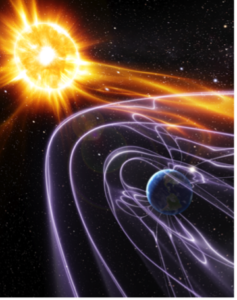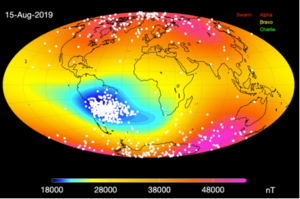Data-driven measuring, modelling and predicting the hole in the Earth’s magnetic field
Data-driven measuring, modelling and predicting the hole in the Earth’s magnetic field
Supervisors: Phil Livermore, Jon Mound
Project partners: British Geological Survey, Danish Technical University, Macau University of Science and Technology
Overview: This data-driven project will measure, model and predict the South Atlantic Anomaly, a weak spot in Earth’s magnetic field. The project will be based on data from European and Chinese satellites,and will use techniques including machine learning to analyse the near space environment and the dynamics of Earth’s liquid core.
Background
The geomagnetic field is a fundamental component of Earth. Wrapping around our planet like an invisible force-field, it protects life from harmful solar radiation and influences the impacts of space weather on modern technologies, such as satellites and electrical power grids. Yet similar to the ozone hole in the atmosphere, there is a weak-spot in this shield, termed the south Atlantic anomaly (SAA). The Earth’s magnetic field is dynamic and changes on yearly to decadal timescales, but unlike the ozone hole the SAA is currently growing. Satellites that fly through this region of weakened field experience electronic upsets (see figure). From 1999 satellites have continuously measured the Earth’s geomagnetic field, the most recent of which is the Macau satellite mission MSS-1, launched in early 2023. These space missions, alongside both recent and historical ground-based measurements, will allow the student to construct data-driven models of the SAA and its space weather implications.


Left: the Earth’s magnetic field acts as a shield from harmful solar radiation. Right: map of temporary electronic failures (single event upsets (SEUs), white dots) on the three Swarm satellites, 2014-2019, which occur primarily in the SAA (shown as blue area) but also in auroral regions.
Objectives
- To map the SAA both in terms of magnetic field strength, observations of energetic particles (e.g. those causing the electronic upsets) and simple models of the positioning of the Earth’s radiation belts which transport these charged particles.
- To use data-driven machine learning, such as physics informed neural networks, to create new models of the Earth’s liquid core, specific to equatorial regions, and consistent with geomagnetic observations. These will complement other global models of the flow, and provide new insight into how and why the SAA arises, and how it may change in the future.
- To assess the space weather hazard of current and future changes in the SAA, for example, by investigating the future geometry of the radiation belts and their impact on spacecraft.
Requirements
We seek a highly motivated candidate with a strong background in mathematics, physics, computation, geophysics or another highly numerate discipline. Knowledge of geomagnetism is not required.
Training
The student will be trained in geomagnetic analysis of measurements from satellites and will take relevant undergraduate or masters level courses. They will also have access to a broad spectrum of training workshops at Leeds that include techniques in numerical modelling, through to managing your degree and preparing for your viva. The student will visit the British Geological Survey in Edinburgh during their studies, and benefit from the strong portfolio of international collaborators of the supervisors, which includes the Macau-mission scientists. There will also be opportunities to attend conferences and collaborative visits both within Europe and internationally.
